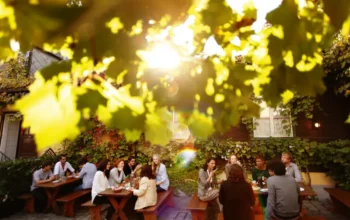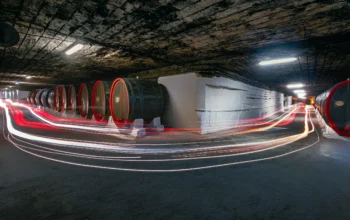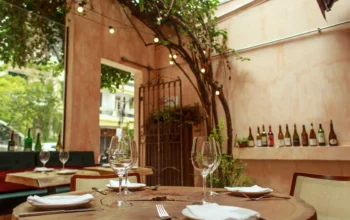Rolling hills in the south and sweeping vistas, a rugged coastline and a mountainous landscape in the north. We drive across Portugal, through a region characterised by cork oaks, olive groves and endless vineyards. An undiscovered place just above the Algarve with a rich history, one of the most beautiful starry skies, surprising culinary traditions ánd special wines: explore the Alentejo.
TEXT ELINE VAN NUNEN PHOTOGRAPHY ELINE VAN NUNEN | LOCAL WINERIES | TOURIST BOARDS
Dry, golden sand drifts up behind our car as we drive onto the grounds of Herdade da Malhadinha Nova in Albernoa. A white oasis in a somewhat African-looking landscape looms before us. We check in for our first night's accommodation and start this round trip at one of the region's finest quality wineries and luxury wine hotels. Malhadinha Nova is a family-run business, the passion for wine has been in its blood for generations. Even the smallest scions do their bit on self-drawn wine labels. The sun enchants the pale blue-painted facades, the estate seems infinite. From this spot you can clearly see how vast and expansive the Alentejo's landscape is.
Alentejan style
'At Malhadinha Nova, we pick everything by hand. We process the grapes into elegant red and white wines. And this is done very carefully,' explains winemaker Nuno Gonzalez. That technique and love for wine are paying off: 'The red Malhadinha has already been voted the second best wine in Portugal!' We follow him to the veranda of the winery. Time for a tasting. And well, why not. With homemade dried ham and sausages, olives and local sheep cheese, we make this Alentejo introduction a party. A comprehensive tour and dinner 'with a view' follow. Portugal the Alentejan way: that tastes like more.
Além do Tejo
The Alentejo is located in the south-central part of Portugal and comparable in area to the Netherlands. The region covers about a third of the country, and can be called sparsely populated with only 750 thousand inhabitants. You will find a great diversity of landscapes and natural beauty. The name Alentejo - além do Tejo - literally means 'across the Tagus'. In the Alentejo, the Tagus forms the natural border with neighbouring Centro region. Above the river, the land is more mountainous, below it is rolling. The water of the Tagus plays an important role for the region's fertile farmland, on which grain and nowadays wine, olives, cork and fruit are grown.
Bread, bacalhau and appetisers
The Alentejo has 100 kilometres of coastline, yet there are remarkably few fish dishes on the local menu. The rocks and rugged coast made it difficult for fishermen to settle there in the 20th century. This was because the fish had to be transported after the catch and was therefore first processed. The dried salted cod (bacalhau) is still often seen on local dinner tables today.
The Alentejo has more than 3,000 hours of sunshine a year and summers can be scorching hot. Not surprisingly, by August the grapes are already ripe for picking and have enormous aromas. If you want to get to know the region's wines better, a visit to the Sala de Provas da Rota dos Vinhos do Alentejo is a good idea. Here you will find information on all the different routes through the region. In addition to tastings and tours, most wineries are also great places to take a look at the local cuisine. It is lunchtime, so we decide to sit down at the restaurant of Herdade dos Grous, a charming winery with a colonnade, fairytale vistas and ditto rose garden. We order the traditional fish soup, but first let the chef surprise us with petiscos, a table full of tasty appetisers.
Heaven for sweet tooths
In the past, the Alentejo has known both Roman and Arab rulers. Both have left their mark on architecture and local gastronomy. Spices like oregano, coriander and garlic have become staples in Alentejan pots and pans. But the combination 'cinnamon, honey and almonds' still plays a starring role in sweet dishes. In the town of Beja, we go in search of the secret of this heavenly combination. Beja is (locally) known for its rich cultural history, the Torre de Menagem as well as for its sweet delicacies. With the warm afternoon sun at our backs, we follow our guide Roberta to the 15th-century church of the local convent of women, which now serves as a museum. Pleasantly surprised, we look around the little church: no tapestry art on the walls here but radiant, blue and white tiles with detailed Bible scenes. 'For decoration, but also as cooling on a hot day like this,' says Roberta. The nuns of the women's convent traditionally ironed and steeped their clothes with egg white. The egg yolk that remained was mixed with almonds and honey and used to bake pastries and biscuits. An ancient craft that - thank God - is still kept alive today. Nowadays, the goodies from Beja are mostly eaten for dessert. Or just as a snack. At tea house Casa de Chá Maltesinhas, we treat ourselves to a tasting of sweets: Maltesinhas, Queijinho do Céu, Papo de Anjo and Túbera to Miminh, Óstia, Pérola and Toucinho do céu (with bacon). Amen!
Read the whole article in WINELIFE #65. You can order here.
Don't want to miss a single edition? Subscribe then subscribe to Winelife magazine now!




